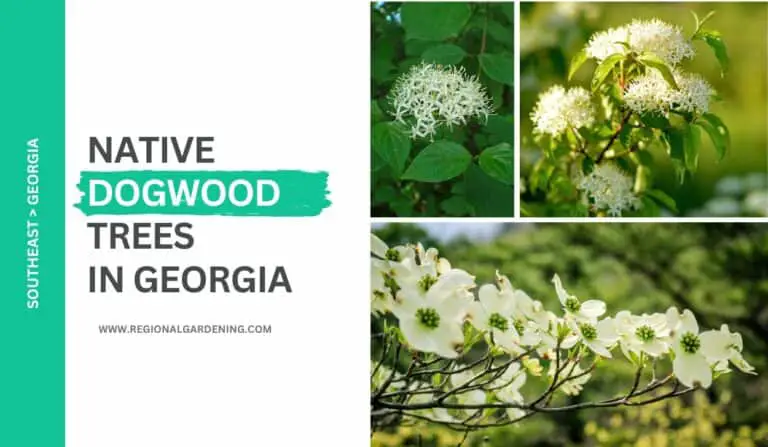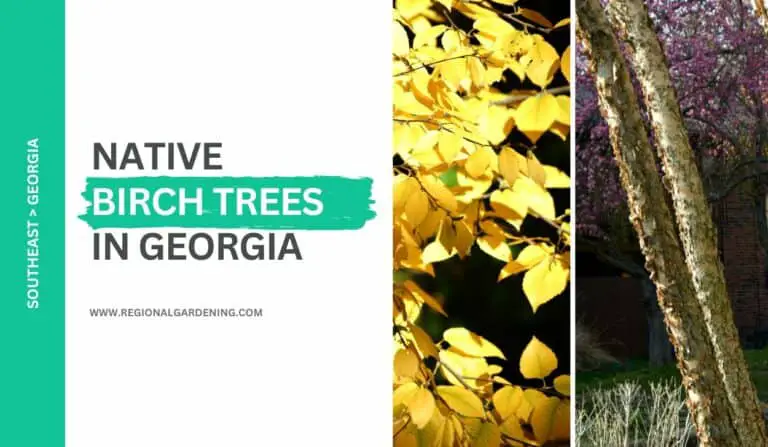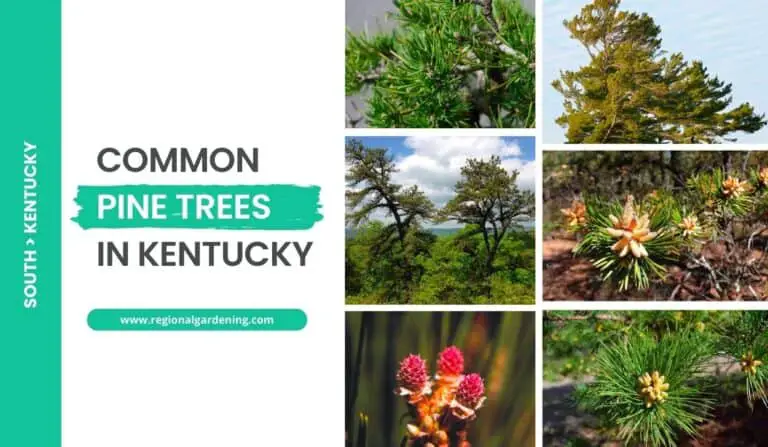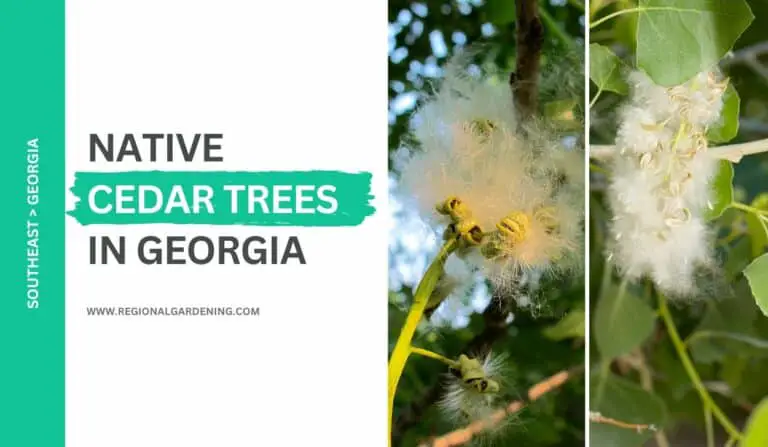18 Native Oak Trees In Georgia (Pictures & Identification)
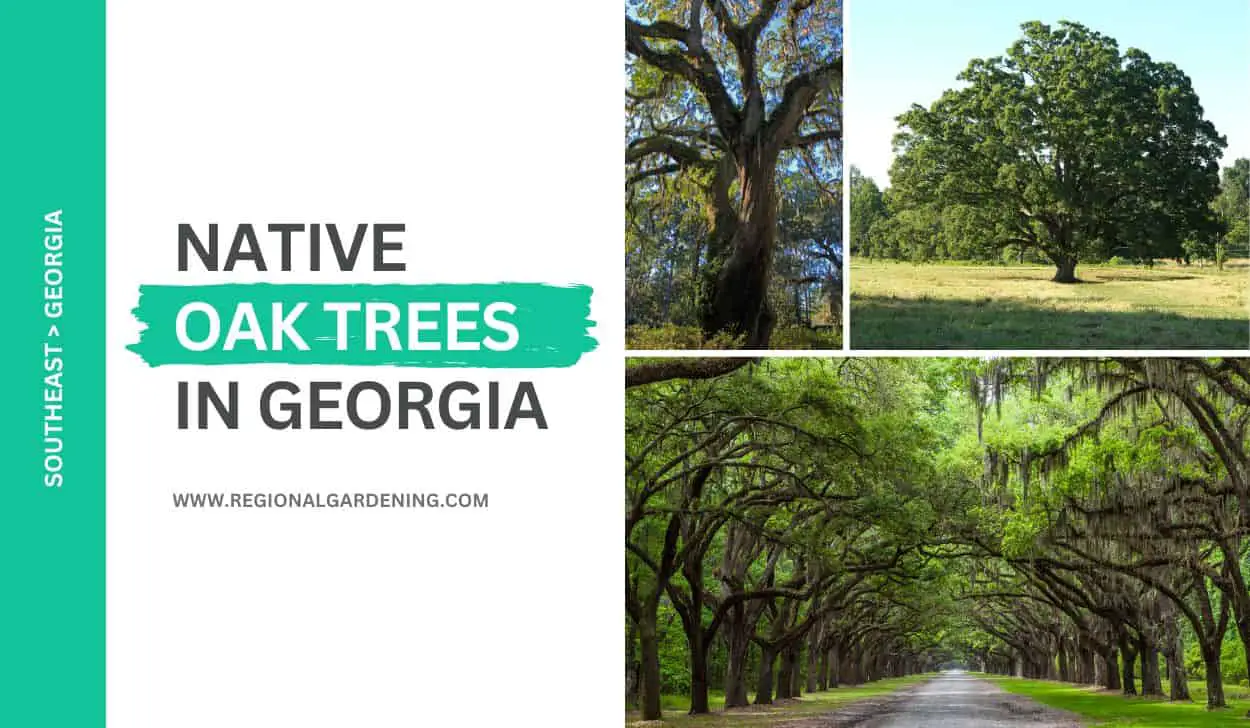
Georgia’s woodlands are home to an extraordinary array of oak trees, each with its unique characteristics and history. From the mighty White Oak, which can grow to over 100 feet tall, to the diminutive Post Oak, these native trees have played an essential role in Georgia’s ecology and culture for centuries.
As you explore the state’s forests, you’ll encounter the Scarlet Oak’s stunning beauty, the Chestnut Oak’s robust strength, and the Blackjack Oak’s resilience.
Each species has a story to tell, and let’s take a closer look at each of these 18 amazing native oak trees in Georgia.
1. Black Oak
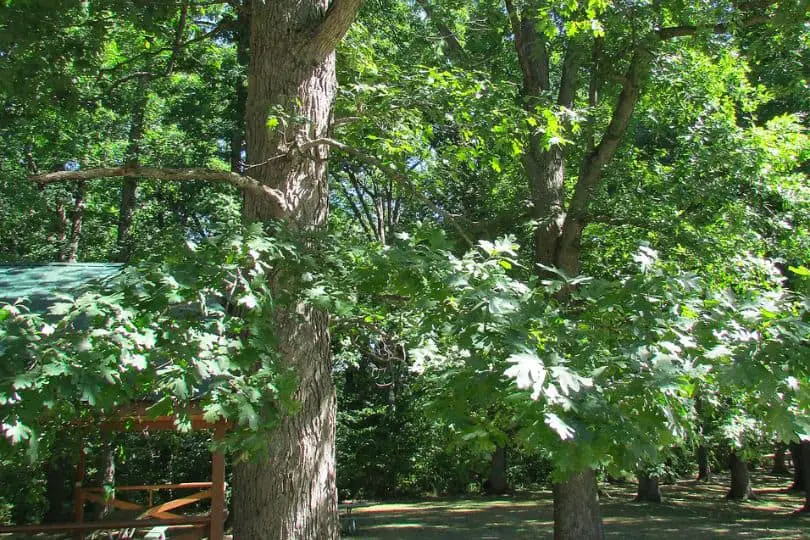
- Common Name: Black Oak
- Scientific Name: Quercus velutina Lamb.
- Mature Height: 70 to 80 feet
- Native/Non-Native: Native
- Flowers/Cones: Large acorns
- Uses: Lumber and fuel
One of the most commonly seen oak trees in Georgia, the Black Oak tree is a magnificent tree that can grow up to 80 feet tall and has a trunk that can be three to four feet in diameter. This red oak-like native tree can be found throughout the state.
The Black Oak tree’s leaves are deciduous, meaning they fall off in the fall, and measure 5 to 8 inches long and 3 to 5 inches wide. They are thick and leathery, with a dark green and lustrous upper side and a yellow-green, brown, or dull copper-colored underside that is generally hairy.
The Black Oak’s fruit is a huge acorn that is light red-brown and hairy, measuring 2/3 to 7/8 inch long and 1/2 to 3/4 inch thick. The Black Oak is distinguished by being encased for half or more of its length in a thin cup.
On juvenile trunks and branches, the bark is smooth and dark brown, but on older trunks, it is severely divided into broad, rounded ridges and is frequently broken into dark brown or practically black, plate-like scales. The Black Oak tree’s inner bark is a remarkably rich orange color.
The Black Oak’s wood is heavy, robust, strong, and coarse-grained, with a rich brown hue tinged with crimson. This wood is used to make lumber as well as fuel. The Black Oak tree is a remarkable and crucial element of our natural environment, whether you are admiring it from afar or using its wood.
2. Blackjack Oak
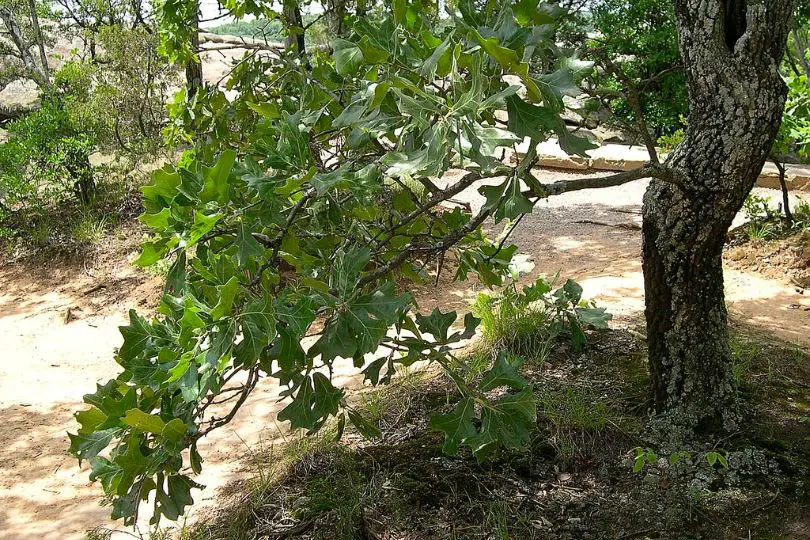
- Common Name: Blackjack Oak
- Scientific Name: Quercus marilandica Muench.
- Mature Height: 20 to 30 feet
- Native/Non-Native: Native
- Flowers/Cones: Acorn
- Uses: Charcoal and fuel
The Blackjack Oak, commonly known as Quercus marilandica Muench., is a native North American tree. It can reach a height of 20 to 30 feet and has a trunk 1 foot in diameter. The tree has a narrow, compact, round-topped, or open head with short, sturdy, often deformed limbs.
The blackjack oak’s leaves are deciduous and change color in the autumn. They have three, occasionally five, very shallow split lobes and are 6 to 7 inches long and broad. The outer end of the lobes has been greatly enlarged, giving the leaves the appearance of a pear portion. The tops of the leaves are smooth, lustrous, and dark yellow-green, while the undersides are hairy and can be yellow, orange, or brown.
The blackjack oak’s fruit is a medium-sized, light yellow-brown, rectangular acorn. The acorn is roughly 3/4 inch long, with a thick cup covering 1/3 to 2/3 of its length. The blackjack oak’s bark is virtually black and deeply split into square plates.
The blackjack oak’s wood is a variety of red oak. It has a pale crimson hue and is hard, weighty, robust, and brittle. The tree may provide charcoal and fuel. From the coast to the mountains, it is frequently found in poor or dry soils.
3. Bluejack Oak
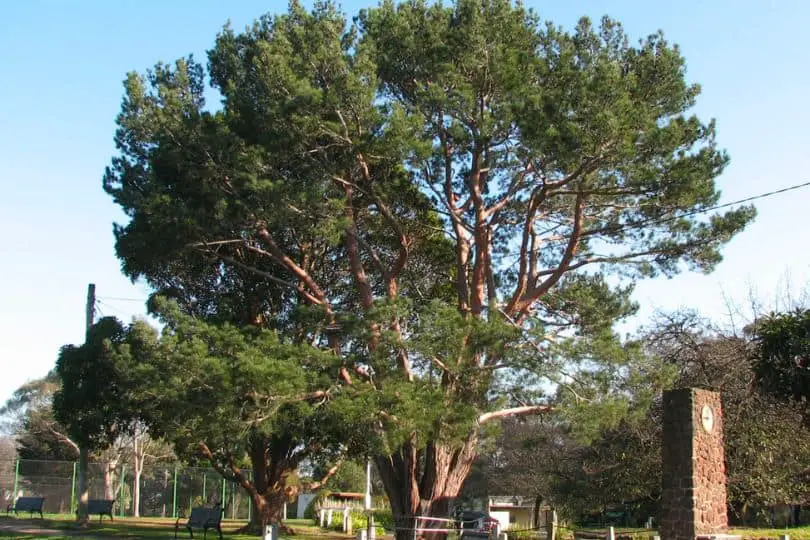
- Common Name: Bluejack Oak
- Scientific Name: Quercus incana Bartr.
- Mature Height: 15 to 20 feet
- Native/Non-Native: Native
- Flowers/Cones: Small acorn
- Uses: Occasionally used for fuel
The Bluejack Oak is a tree native to the coastal plain that thrives in dry hills. It can reach a height of 15 to 20 feet and has a trunk diameter of 5 to 6 inches. It can grow even bigger on damp soils.
The leaves of this tree are rectangular and pointed at each end, with smooth margins. They are blue-green and lustrous on top, but pallid and hairy on the bottom. The leaves turn deciduous and fall off throughout the autumn season.
The Bluejack Oak’s fruit is a little acorn that is hairy at the tip and encased in a thin, saucer-shaped cup just at the base or for half its length.
The tree’s bark is separated into thick, nearly square plates and coated in small, dark brown to nearly black scales. The wood is firm, durable, close-grained, and light brown with a crimson tinge. While the Bluejack Oak is used for fuel on occasion, it is not often used for anything else.
Bluejack Oak is most commonly found on the dry pine flats of the coastal plain, but it can also be found in the lower Piedmont. Overall, it’s a lovely tree with distinct characteristics that add to the diversity of the habitat in which it thrives.
4. Chestnut Oak
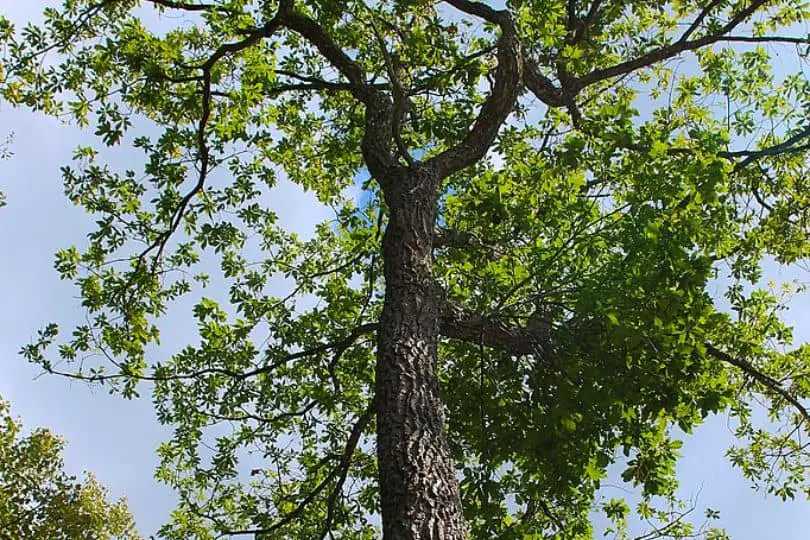
- Common Name: Chestnut Oak
- Scientific Name: Quercus prinus L.
- Mature Height: 60 to 70 feet
- Native/Non-native: Native
- Flowers/Cones: Shiny egg-shaped acorns
- Uses: Fence posts, railroad ties, fuel, tannin source
One of the strongest oak trees in Georgia, the Chestnut Oak, scientifically known as Quercus prinus L., is a magnificent tree endemic to North America. Its leaves are a lovely dark green hue and deciduous, meaning they fall off in the autumn.
They can grow to be up to 9 inches long and 3 inches wide, with an oblong shape that tapers at each end. The leaves are lustrous and dark green above and pale and slightly hairy below, with a scalloped or wavy edge.
The fruit of the Chestnut Oak is an egg-shaped acorn that is 1 to 1-1/2 inches long and glossy. A narrow cup surrounds the acorn for 1/3 to 1/2 of its length, and the kernel is not bitter. On mature trees, the bark of the Chestnut Oak is grayish-brown and heavily furrowed.
The Chestnut Oak can reach heights of 60 to 70 feet and has a trunk diameter of 3 to 4 feet. It typically has huge arms that extend out 15 to 20 feet above the ground, forming a broad, uneven head shape. It prefers stony slopes and bluffs in the upper Piedmont and mountain regions and is frequently found on upland soils.
The wood of the Chestnut Oak is dense, durable, robust, and close-grained. It is resistant to soil contact, making it ideal for fence posts, railroad ties, and fuel. Previously, the bark of the Chestnut Oak was employed as a tannin source.
5. Georgia Oak
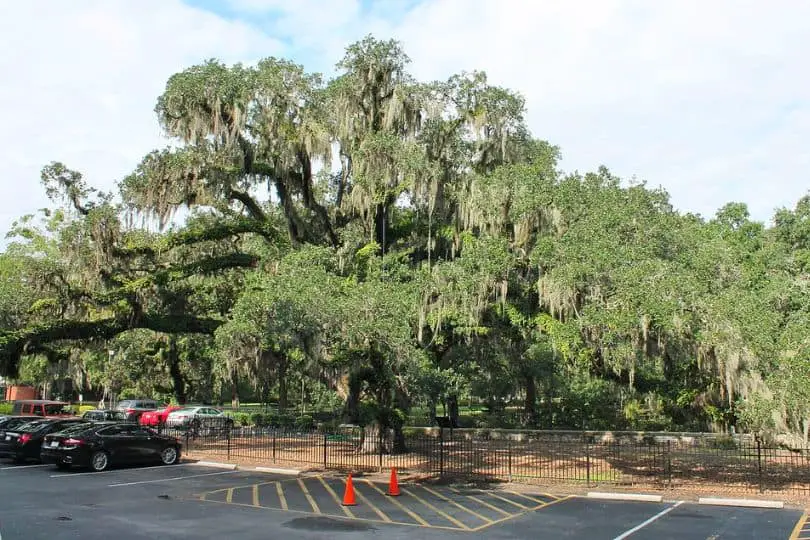
- Common Name: Georgia oak
- Scientific Name: Quercus georgiana M. A. Curtis
- Mature Height: Seldom reaches a height of 25 feet, more often a shrub only a few feet in height
- Native/Non-Native: Native to Georgia
- Flowers/Cones: Produces shiny acorn that is light red-brown and 1/3 to 1/2 inch long
- Uses: Not of sufficient size to be of any commercial use
Georgia Oak is one of the shortest native oak trees in Georgia that can reach a maximum height of 25ft.
The leaves of the tree are deciduous, meaning they fall off in the autumn and measure around 2 1/2 inches long and 1 1/2 inches wide. They have 3 to 5 broadly divided, smooth margined, or serrated lobes and are brilliant green and lustrous above, lighter and smooth below, except for hair tufts in the vein axils.
The fruit of the Georgia oak is a light red-brown, glossy acorn that is 1/3 to 1/2 inch long and sits in a shallow cup.
The bark of the Georgia Oak is dark gray stained with crimson and unevenly wrinkled, and the tree rarely grows taller than 25 feet, preferring to be a shrub of a few feet tall. The tree bears tiny leaves with 3 to 5-toothed lobes and an acorn in a shallow cup. Georgia oak wood is a hefty, strong, durable, and light brown-red oak.
However, the tree is not large enough to be of commercial use. The Georgia Oak is only found in Georgia, on a few granite hills such as Stone Mountain, Little Stone Mountain, and others in Jackson, Polk, and Meriwether Counties.
6. Laurel Oak
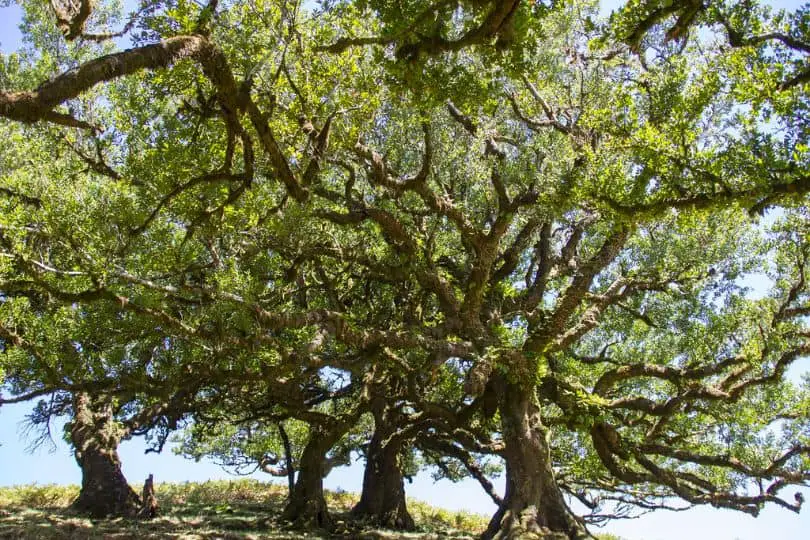
- Common Name: Laurel Oak
- Scientific Name: Quercus laurifolia Michx.
- Mature Height: Up to 100 feet
- Native/Non-Native: Native
- Flowers/Cones: Acorn
- Uses: Used as an ornamental shade tree and for fuel.
The Laurel Oak is a huge deciduous tree with a trunk up to 4 feet in diameter and a height of up to 100 feet. This tree has elliptic leaves that are around 3 to 4 inches long and 3/4 inches wide.
The leaves are shortened at both ends and have smooth borders. The tops of the leaves are green, lustrous, and smooth, while the bottoms are light green, less shiny, and smooth.
The Laurel Oak produces an egg-shaped or hemispherical dark brown to virtually black acorn approximately 1/2 inch long with a thin, saucer-shaped cup. After the second season, the acorns reach maturity. On young stems, the bark is dark brown and smooth, but on older trunks, the bark turns black and is strongly wrinkled into broad, flattened ridges.
The wood of the Laurel Oak is heavy, strong, and hard, with a coarse grain that checks heavily when dried. The wood is dark brown with a red hue. Except as a fuel source, this tree has minimal use and is commonly grown as an attractive shade tree.
The Laurel Oak is a North American native that grows on moist soils and along streams, primarily on the coastal plain. The Laurel Oak has elliptic leaves with complete margins that fall in the spring of the second season, as well as dark, deeply furrowed, and ancient trunks.
7. Live Oak
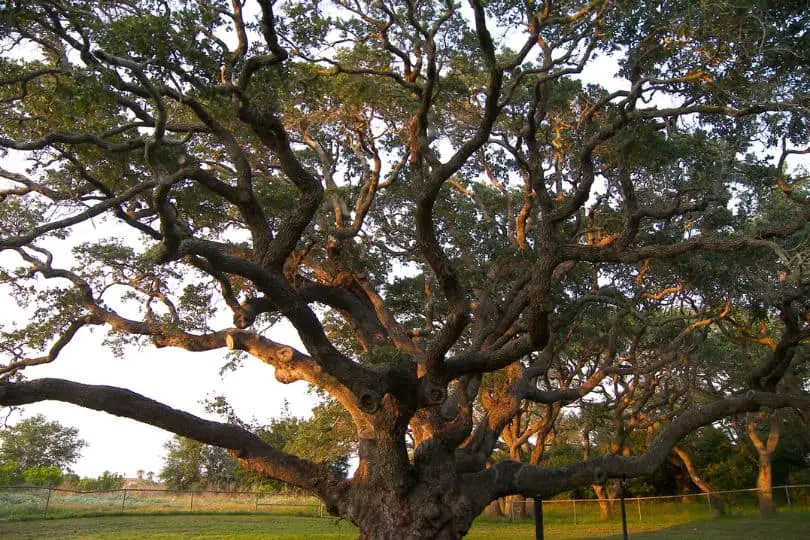
- Common Name: Live Oak
- Scientific Name: Quercus virginiana Mill.
- Mature Height: 40 to 50 feet high
- Native/Non-Native: Native
- Flowers/Cones: Acorn
- Uses: Ornamental shade tree; Georgia’s official State Tree; formerly used in ship-building
One of the most commonly found native oak trees in Georgia, the live oak tree is a native tree that can reach heights of 40 to 50 feet.
It is an evergreen tree, thus its leaves remain green all year. The leaves are thick and leathery, with an oval form. They can range in size from 2 to 5 inches long and 1/2 to 2 1/2 inches wide. The smooth, bright green leaves have slightly curled edges and a few teeth towards the tip. The undersides of the leaves are light and hairy if you look closely. The leaves of the tree fall off in the spring of their second season.
The oblong acorns produced by Live Oak are around 3/4 inch long. The acorn is dark, with a blackish-brown visible portion and a yellowish cup. For 1/3 to 1/2 of its length, the acorn is encased in a cup. The tree has a spreading aspect, while an upright version can be found in some regions.
Live oak is a light brown or yellow tree that is highly hefty, sturdy, powerful, and tough. It was previously employed in shipbuilding due to its massive size and strength. It is now largely employed as an ornamental shade tree.
The official state tree of Georgia is the Live Oak, which grows in abundance near the shore and westward in the lower coastal plain.
8. Northern Red Oak
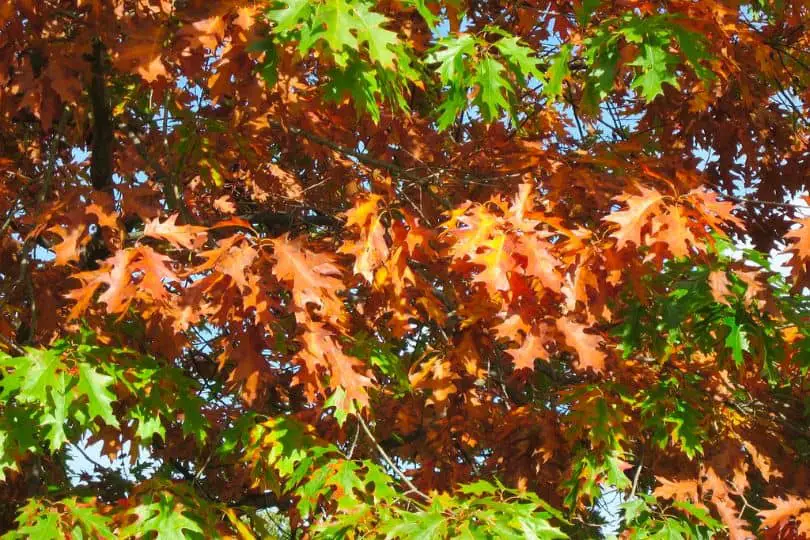
- Common Name: Northern Red Oak
- Scientific Name: Quercus rubra L.
- Mature Height: 70 to 80 feet
- Native/Non-Native: Native
- Flowers/Cones: Egg-shaped acorn, 2/3 to 1 1/4 inches long, with a thick cup at the base
- Uses: Construction, furniture, fuel
The Northern Red Oak is a stunning deciduous tree that may reach heights of 80 feet! Its leaves are green and smooth on top, but pale yellow-green and smooth underneath. The leaves turn hues and fall off the tree in the fall. The leaves feature small, bristle-tipped lobes that give them a distinct appearance.
The Northern Red Oak produces enormous and broad egg-shaped acorns. These acorns provide nourishment for creatures like squirrels and chipmunks.
The upper trunk has smooth, dark brownish-gray bark with lighter gray vertical lines. The bark on the lower trunk is dark grayish-brown and split into small, thick plates.
Northern Red Oak wood is hefty, sturdy, and strong, but not as long-lasting as white oak wood. The wood is a mild reddish-brown tint. Wood is utilized for construction, furniture, and fuel because of its strength and beauty.
Northern Red Oak is a native of North America, and it can be found in good soil near the boundaries of lowlands and along small streams. It grows abundantly in the highlands and piedmont but is scarce near the shore.
9. Overcup Oak
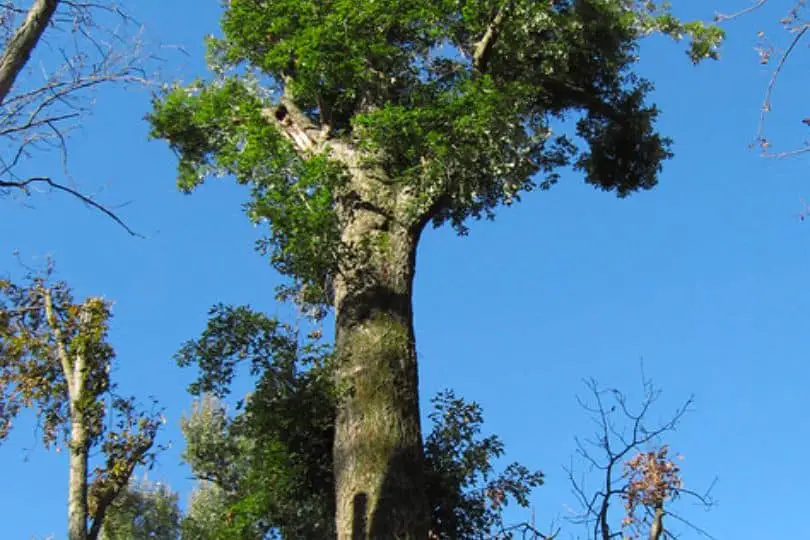
- Common Name: Overcup Oak
- Scientific Name: Quercus lyrata Walt.
- Mature Height: 50 to 75 feet
- Native/Non-Native: Native
- Flowers/Cones: Produces egg-shaped acorns
- Uses: The same as white oak – for furniture, construction, and flooring.
The Overcup Oak is one of the not-so-popular oak trees in Georgia. It is a lovely tree with a rounded head that can grow up to 75 feet tall and has a trunk up to 3 feet in diameter.
The Overcup Oak’s leaves are deciduous, which means they fall in the autumn. They are large, dark green, and smooth on top, with silvery-white undersides that are hairier or practically smooth. The Overcup Oak’s acorns are egg-shaped and almost fully encased by a cup.
Overcup Oak bark is gray, thick, and scaly, with deep ridges. This tree’s wood is heavy, sturdy, strong, and long-lasting when exposed to soil. It has a deep color, similar to white oak, and is suitable for manufacturing furniture, building materials, and flooring.
The Overcup Oak is a North American native that is usually found in stream bottoms and lush lowlands. It thrives in swamps near the coast and has been seen in certain inland locations of Georgia.
10. Post Oak
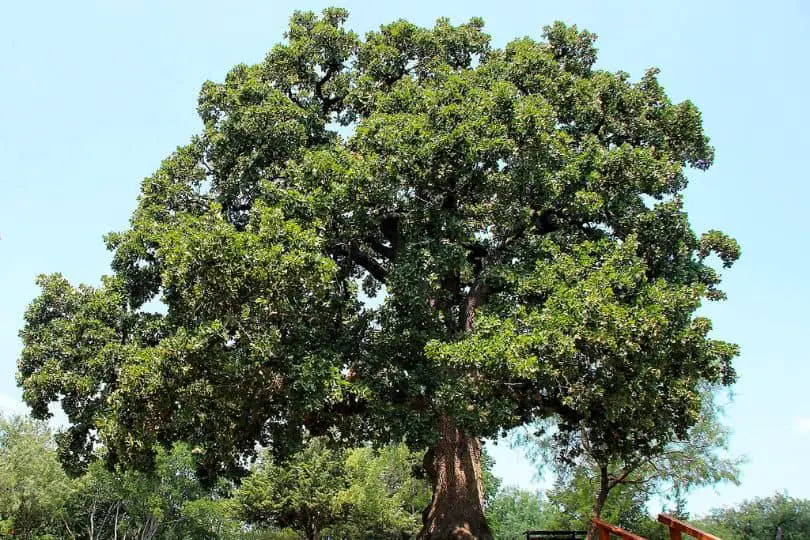
- Common Name: Post Oak
- Scientific Name: Quercus stellata Wangenh.
- Mature Height: 50 to 60 feet
- Native/Non-Native: Native
- Flowers/Cones: Produces acorns
- Uses: Fence posts, railroad ties, cooperage, construction, fuel
The Post Oak is a beautiful tree that can be seen all over the state. It can reach a height of 50 to 60 feet and has thick, leathery dark green leaves that turn yellow in the autumn.
The leaves are 4 to 5 inches long and wide, with deeply lobed divisions that are broad and rounded. The lobes of the leaves are the broadest at the ends, giving the leaves a cross-shaped outline.
The tree bears rectangular, blunt acorns that mature in a single season. The acorns are 1/2 to 3/4 inch long and have a cup covering 1/4 to 1/3 of the acorn. On older trees, the bark is dark gray and finely checked, with long, horizontal fissures. The tree’s limbs are twisted, and the twigs are hairy.
The wood of the Post Oak is valued because it is white oak, hefty, robust, close-grained, resilient in contact with soil, and light or dark brown.
Its lumber frequently has numerous tiny knot clusters. Fence posts, railroad ties, slack cooperage, general construction, and fuel are all made from the tree.
The Post Oak is one of the distinct and valuable oak trees in Georgia, with numerous applications. Its distinctive characteristics, such as cross-shaped leaves, deeply lobed dark green leaves, and crooked branches, make it a lovely addition to any landscape.
11. Scarlet Oak
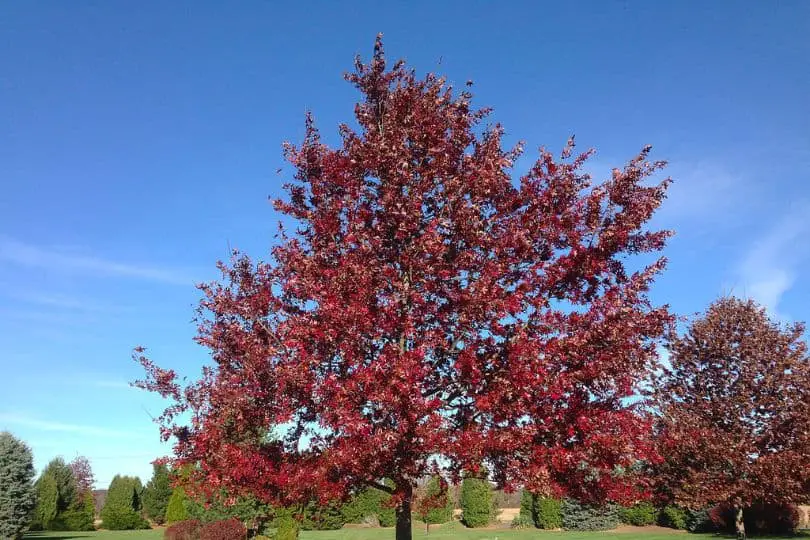
- Common Name: Scarlet Oak
- Scientific Name: Quercus coccinea Muench.
- Mature Height: 70 to 80 feet
- Native/Non-native: Native
- Flowers/Cones: Oval to oblong acorns
- Uses: Furniture, flooring, and cabinetry
Quercus coccinea Muench. is a tall deciduous tree endemic to North America. It matures to a height of 70 to 80 feet and has a small open head. The bark of the tree is dark brown to practically black, with uneven ridges divided by shallow crevices.
Scarlet Oak leaves are narrow, brilliant green, smooth, and shiny on top and paler and smoother on the bottom. It measures 3 to 6 inches long, 2 12 to 4 inches wide, and has 7 to 9 deeply split, bristle-tipped lobes; the stem or petiole is spherical, 1 12 to 2 12 inches tall, and typically reddish green. It’s a lovely tree with fiery red foliage in the autumn.
Scarlet Oaks yield acorns that are oval to oblong in shape, 12 to 1 inch long, 1/3 to 2/3 inch thick, and light reddish-brown, with two or more rings around the tip. The broad bowl-shaped cups that surround the acorn are about halfway enclosed. Scarlet Oak’s kernel is bitter and virtually white.
The wood of the tree is heavy, robust, sturdy, and coarse-grained, with a pale or reddish-brown color. Its uses are comparable to those of other red oaks, such as lumber for furniture, flooring, and cabinetry.
Scarlet oaks are typically found in dry, sandy soils throughout North America. They are found across the state, although are more common in the Piedmont and mountains and are uncommon near the coast.
Scarlet oak is an important attractive landscape tree that provides food and habitat for a variety of wildlife species, including wild turkeys, squirrels, and deer.
12. Shumard Oak
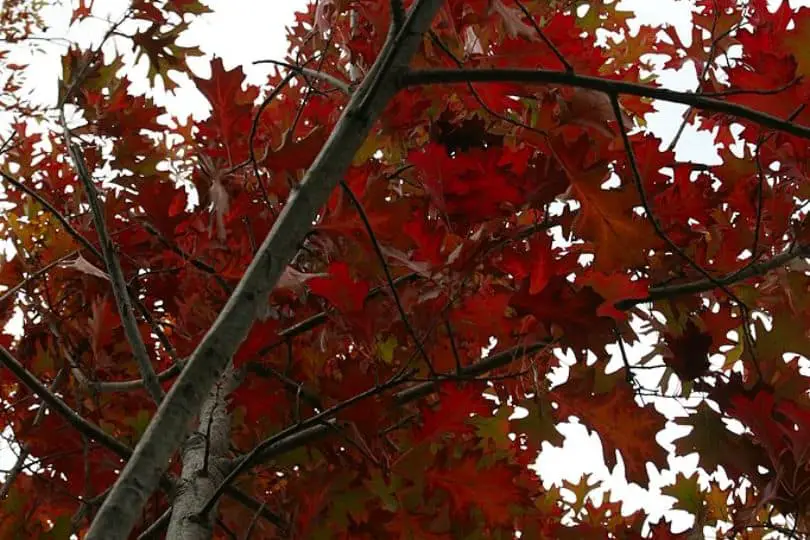
- Common Name: Shumard Red Oak
- Scientific Name: Quercus shumardii Buckley
- Mature Height: Up to 100 feet
- Native/Non-Native: Native
- Flowers/Cones: Egg-shaped acorn
- Uses: Similar to Southern Red Oak
The Shumard Red Oak is a lovely tree with a wide-spreading head that can grow to reach over 100 feet tall. It has 5 to 7-lobed, dark green leaves on top that are paler below with hair clusters. Its leaves become yellow and fall off in the autumn. It is indigenous to North America and thrives in damp, fertile soil near streams.
This tree produces acorns that are egg-shaped and about an inch long, with a thick, flat, saucer-shaped cup. On younger trees, the bark is smooth, but on older trees, it becomes rough and black.
Shumard Red Oak wood is dense, durable, and close-grained. It’s a light reddish-brown color that’s commonly used for flooring, furniture, and cabinetry. The Shumard Red Oak is related to the Southern Red Oak, which serves similar functions.
The Shumard Red Oak is usually found along the coast and on Piedmont, all the way up to Oglethorpe County. It adds a lovely addition to any environment and provides a haven for wildlife such as squirrels and birds.
13. Southern Red Oak
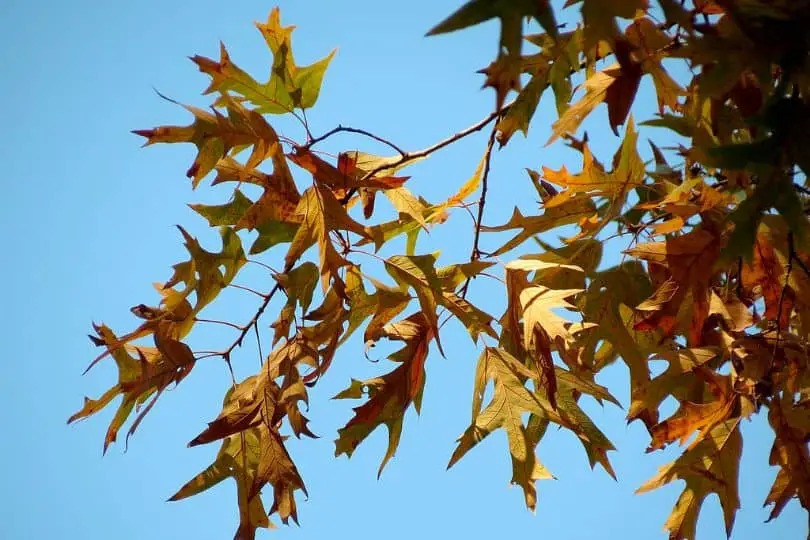
- Common Name: Southern Red Oak
- Scientific Name: Quercus falcata Michx.
- Mature Height: 70-80 feet
- Native/Non-Native: Native
- Flowers/Cones: Short acorn about 1/2 inch
- Uses: Lumber, furniture, and flooring; bark formerly a source of tannin
The Southern Red Oak tree is a gorgeous North American native that can grow to reach 70-80 feet tall. This tree’s leaves are deciduous, which means they fall throughout the autumn season.
The leaves are 6 to 7 inches long and 4 to 5 inches wide, with 3 to 5 bristle-tipped, highly pointed lobes. The central lobe is long and narrow, while the leaf base is rounded and often lopsided. The leaf’s upper surface is dark green and lustrous, while the undersurface is rust-colored and hairy.
The Southern Red Oak’s fruit is a small acorn about 1/2 inch long and brilliant orange-brown. It matures at the end of its second season and is encased in a flat cup for less than one-third of its length. The acorn kernel is bitter, and it is not consumed.
Southern Red Oak bark is dark brownish-grey with narrow, shallow ridges. The tree’s wood is firm, sturdy, coarse-grained, and light red. This wood is utilized in the production of lumber, furniture, and flooring.
The Southern Red Oak tree is a widespread upland species throughout the state. It is an excellent addition to any landscape or park, adding both beauty and shade.
14. Swamp Chestnut Oak
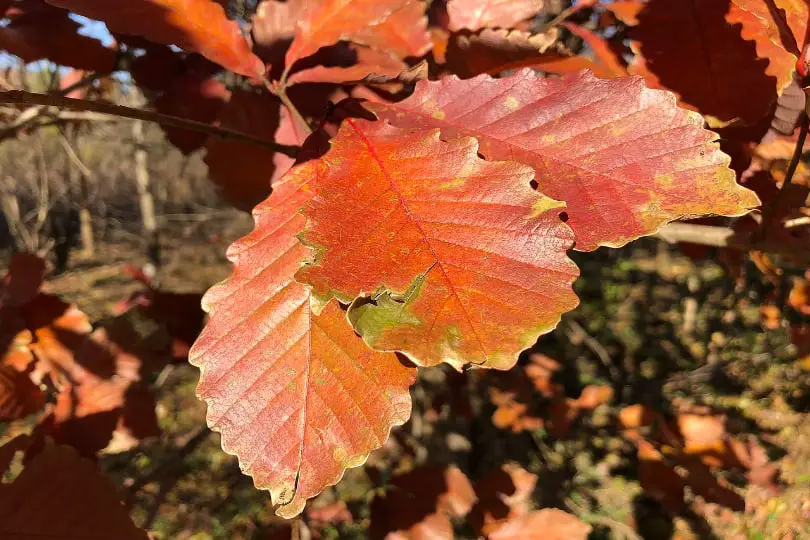
- Common Name: Swamp Chestnut Oak
- Scientific Name: Quercus michauxii Nutt.
- Mature Height: 60 to 80 feet
- Native/Non-Native: Native
- Flowers/Cones: Smooth acorns
- Uses: Construction, agriculture implements, fuel, baskets
The Swamp Chestnut Oak is a huge, deciduous tree that can reach heights of 80 feet. It has oblong, tapering leaves that range in length from 4 to 9 inches and width from 2 3/4 to 4 1/4 inches.
On top, the leaves are green and lustrous, while beneath, they are pale green to silvery white and hairy. The tree produces acorns that are smooth, egg-shaped to oblong, 1 to 1 1/2 inches long, and have a thick saucer-shaped cup surrounding them for no more than 1/3 of their length. The acorn’s kernel is edible.
The bark of the Swamp Chestnut Oak is silvery-white or ashy-gray and scaly. Its leaves resemble those of a chestnut but are wider, especially above the middle, and hairy below.
The Swamp Chestnut Oak’s wood is heavy, hard, highly robust, tough, close-grained, long-lasting, and light brown.
The Swamp Chestnut Oak is native to the southeast coastal plain and extends into the Piedmont as far north as Clarke County.
The tree can be used for a variety of purposes, including building, agricultural implements, wheels, cooperage, fence posts, baskets, and fuel. It serves the same purpose as white oak.
15. Turkey Oak
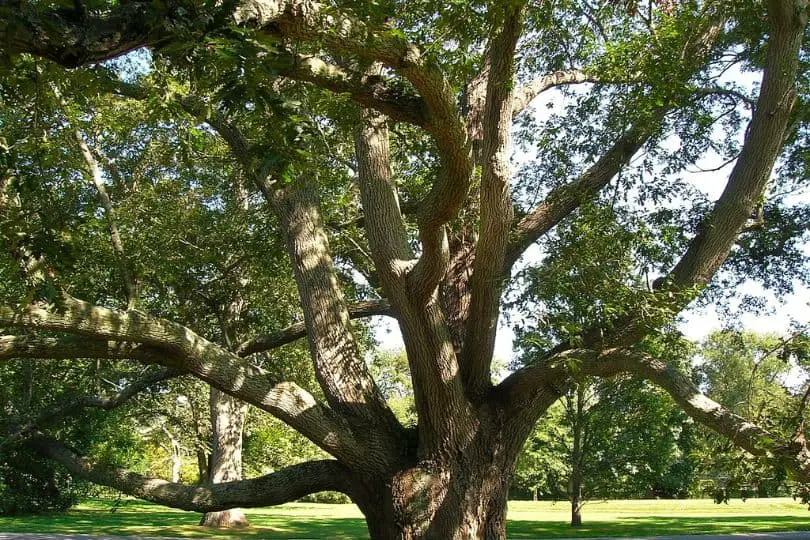
- Common Name: Turkey Oak
- Scientific Name: Quercus laevis Walt.
- Mature Height: 20 to 30 feet
- Native/Non-Native: Native
- Flowers/Cones: Oval, light brown, hairy acorn
- Uses: Fuel
The Turkey Oak is one of the shortest oak trees in Georgia and can reach a maximum height of only 30 feet.
It has deciduous leaves that fall off in the fall. They have 3, 5, or 7 bristle-tipped lobes and are 3 to 12 inches long and 1 to 10 inches wide. The lateral lobes are frequently bent and extended. They have a thick and bright yellow-green top, a smooth and shiny bottom, and a paler, shiny, and smooth top. The petioles, or stems, are quite short.
The fruit of the Turkey Oak is an oval, light brown, hairy acorn about 1 inch long and 3/4 inch wide. It is encased in a narrow cup for about one-third of its length.
The bark of the Turkey Oak is dark gray with crimson undertones on the surface, and it is nearly black on older trunks. The inner bark is crimson, heavily furrowed, and irregularly wrinkled. The limbs of the Turkey Oak are thick and twisted, forming an open, round-topped, irregular head.
The leaves of the Turkey Oak have 3 to 5 strongly split lobes, and the laterals frequently bend. Its bark is dark gray with scarlet undertones and heavily furrowed into little squares. Turkey Oak wood is heavy, robust, sturdy, coarse-grained, and pale reddish brown. Except for fuel, it has little value.
The Turkey Oak is native to the coastal plain’s sand hills and low soils. It is a lovely tree that is occasionally utilized in landscaping. Its acorns are a valuable source of food for squirrels, deer, and other animals.
16. Water Oak
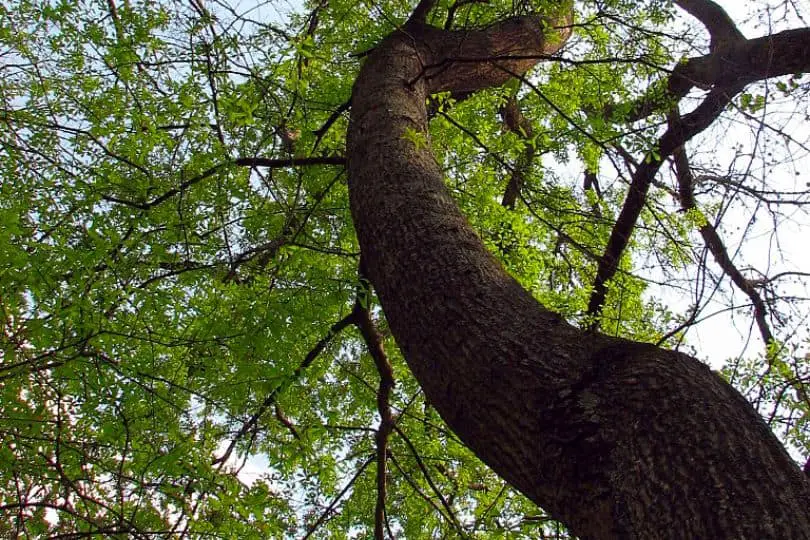
- Common Name: Water Oak
- Scientific Name: Quercus nigra L.
- Mature Height: 70 to 80 feet
- Native/Non-Native: Native
- Flowers/Cones: Acorn
- Uses: Lumber and Ornamental Plant
Water oak trees are native to the southeastern United States. It may reach heights of 70 to 80 feet and has a trunk diameter of 2 to 3 feet. It features a symmetrical, circular, and complete head at the top.
Except for hair tufts in the axils of the larger veins, the Water Oak’s leaves are deciduous in winter, with a bluish-green tint on top and a whiter, smoother underside. The leaves are 2 1/2 inches long and 1 1/2 inches wide, with a constricted base and a wider, rounded, and frequently 3-lobed tip.
The tree bears a nearly spherical acorn with a flat base that is light yellow-brown, hairy, and only has a thin saucer-shaped cup at the base. The acorn kernel is bitter and matures over two seasons.
Water Oak bark is gray-black, close, and often uneven on older trunks with rough, broad, and scaly ridges. Water Oak wood is a red oak variant with a light brown tint that is heavy, sturdy, and strong.
This tree is widely planted as an ornamental and is a significant red oak lumber species. Water Oak trees can be found growing along stream banks and in low areas in the southeastern coastal plain and Piedmont regions of the United States.
17. White Oak
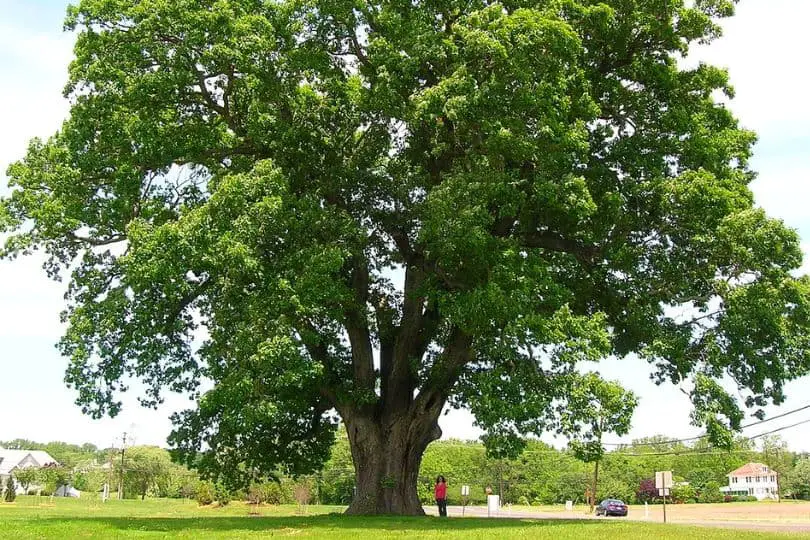
- Common Name: White Oak
- Scientific Name: Quercus alba L.
- Mature Height: 80 to 100 feet
- Native/Non-Native: Native to North America
- Flowers/Cones: Produces acorns
The light gray, ridged, or flaking bark of white oak is easily recognizable. When grown in the open, the tree’s trunk can grow to reach 3 to 4 feet in diameter, and its branches form a broad, rounded head.
This tree is native to North America and can be found throughout the country, with the exception of near the coast. It grows best on rich uplands or damp bottomlands in the Piedmont and lower mountains.
White oak is a valuable hardwood because it is strong, heavy, and long-lasting. Furniture, millwork, tight cooperage, veneer, vehicle construction, crossties, handles, agricultural equipment, fence posts, and fuel are all made from its light brown wood.
Finally, White Oak is a magnificent tree known for its beauty, strength, and versatility. It is a valuable resource that humans have used for ages and that remains a significant part of our lives today.
18. Willow Oak

- Common Name: Willow Oak
- Scientific Name: Quercus phellos L.
- Mature Height: 70 to 90 feet
- Native/Non-Native: Native
- Flowers/Cones: Small acorn fruit
- Uses: Shade tree and lumber
The Willow Oak is a massive tree that can grow to be 70 to 90 feet tall. It has a 2-foot diameter slender stem and a small, open or conical, round-topped head. Willow Oak leaves are deciduous, which means they fall off in autumn.
The leaves are slender and willow-like, with pointed tips on both ends. They have a light green top that is smooth and sparkly, and a dull, paler, and usually smooth bottom. The edges of the leaves are smooth, with the exception of a bristle on the tip.
Willow Oak fruit is a small, nearly spherical, or egg-shaped acorn about 1/3 inch thick. Only the base of the acorn is encased in a shallow flattened cup, and it is hairy. At the end of the second season, the acorn matures.
Willow Oak bark is dark gray and smooth in general, although on older trunks, it can be shallowly split into uneven plates. The tree’s winter buds are sharp-pointed, thin, and smooth.
In terms of wood, the Willow Oak is a red oak. Its wood is heavy, sturdy, and coarse-grained, with a light-brown color that has a red tinge to it. The tree is widely planted as a shade tree and is commonly used as lumber.
The Willow Oak is a common tree in the flats and low areas of the coastal plain, and it can spread into the Piedmont. It can be found in Clarke and Oglethorpe Counties.
Similar Articles
- Native Pine Trees In Georgia
- Native Dogwood Trees In Georgia
- Native Hickory Trees In Georgia
- Native Maple Trees In Georgia
- Native Tupelo Trees In Georgia
- Native Plum Trees In Georgia
- Native Magnolia Trees In Georgia
- Native Willow Trees In Georgia
- Native Ash Trees In Georgia
- Native Elm Trees In Georgia
- Native Cottonwood Trees In Georgia
- Native Cedar Trees In Georgia
- Native Birch Trees In Georgia
- Common Purple Trees In Georgia
- Common Cypress Trees In Georgia
- Common Palm Trees In Georgia
- Common White Flowering Trees In Georgia
Native Oak Trees In Georgia – Sources
The Regional Gardening team makes sure that the information in our articles is accurate by only using sources that are known to be trustworthy. Some of these sources are peer-reviewed journals from government agencies, well-known universities, and scientific research organizations.
- Georgia Native Plant Society
- College Of Agricultural & Environmental Sciences, University Of Georgia
- Native Plants Books, Georgia Native Plant Society
- Georgia Forestry Commission
- Native Plants Of North Georgia, University Of Georgia
- Tree Care, Georgia Tree Council


